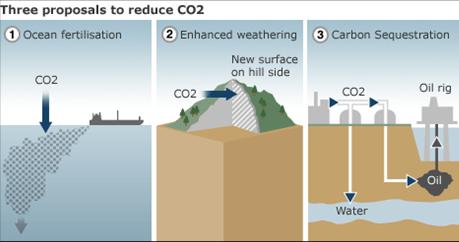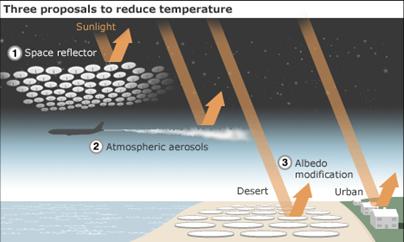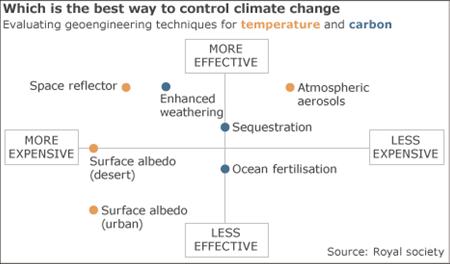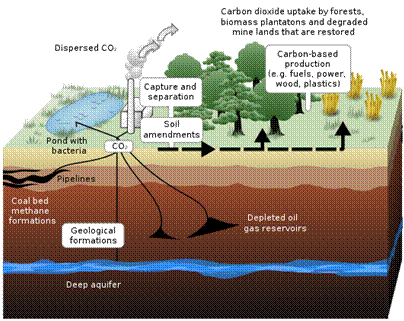
CLIMATICO CHANGE .How technology could help us beat climate change
30 diciembre, 2009 Autor: admin
New technologies will be required if the world economy is to grow without accelerating climate change. ( BBC 2009)
Since the industrial revolution, economic growth has gone hand in hand with the consumption of fossil fuels and the release of ever greater amounts of carbon dioxide into the atmosphere – leading many scientists and politicians to call now for a new, technological revolution. Here we survey options for power-generation and transport, and also engineering solutions to reflect sunlight or remove CO2 from the atmosphere.
Power-generation
| Clean coal |
Range of technologies to pre-treat coal to reduce emissions, burn it more efficiently, or capture and store carbon emissions. | Most abundant and widely distributed fossil fuel. Preserves existing industry and makes use of existing infrastructure. | Uses more coal per kWh than normal coal power. Produces some pollutants, such as heavy metals. Coal is a finite resource. | Small-scale trials under way. Huge investment(c $3trn) needed by 2050. Estimated cost: 5-13 cents/kWh (double normal coal). |
……………………………………………………………………………………………………………….
| Geothermal |
Uses naturally hot rocks, or temperature differences, beneath Earth’s surface to heat water directly or drive turbines. | Constant renewable energy source in some locations. Highly efficient for heating living spaces. Long hardware lifetime. | Underground heat only available in some locations. Energy can «dry up» for years. Can in some locations release toxic gases. | Currently less than 1% of global capacity. US and Australia investing in new technologies. Estimated cost: 5-11 cents/kWh. |
………………………………………………………………………………………………….
| Nuclear | Harnesses energy from the controlled splitting of atoms, releasing heat that is harvested to drive turbines. | Significant historical experience and technology developed. Can provide heat and electricity. Plentiful fuel supplies. | Perceived as risky. Strong opposition from green campaigners. Creates radioactive waste. Fuel can be weapons security risk. | Set for a comeback after years in shadow. New reactors behind schedule. Disputed cost. One estimate: 4-8 cents/kWh |
————————————————————————————————-
| Marine |
Exploits energy of shifting tides, underwater currents, or shoreline and offshore waves. | Large and infinitely renewable resource. Tidal energy very regular. Can be exploited on small or large scale. | No consensus on best means to capture energy. Large projects may disrupt natural water flow, tides and ecosystems. | Little expected before 2030. Technology uncertain, so wide cost range: 15-30 cents/KWh (double or triple coal). |
——————————————————————————————
| Wind | Using the wind, on land or at sea, to drive turbines. | Significant experience and mature industry and infrastructure. Infinitely renewable resource. Can be deployed in range of project sizes. | Intermittent resource. Not efficient for all locations. Windfarms interrupt radar signals, can be noisy and regarded by some as unsightly. | Currently about 1% of global supply. Onshore cheaper than offshore. High energy storage costs are handicap. Quite low cost: 7-14 cents/kWh |
| Solar | Gathers energy from sunlight, using light to generate electricity directly (photovoltaic) or to heat liquids to drive a turbine. | Infinitely renewable and most abundant zero-carbon resource. Silent and no effects on local environment. | Like wind and marine, intermittent. Current photovoltaic designs complex; if widely used, chemicals could become scarce. | US investing heavily, EU planning plant in Africa. Cost still high (13-35 cents/kWh) but expected to fall. Price of solar panels falling. |
————————————————————————————
| Hydroelectric |
Generates electricity by damming water and constraining flow through turbines. Most widely deployed renewable strategy. | Well-established as a large-scale energy source. Can also be used for energy storage if run in reverse. | Dams disrupt ecosystems and are a public health risk if they burst. Can trap decaying matter that creates pollution. | One of the cheapest forms of electricity. Development focusing on small hydro-electric power. Estimated cost: 2-6 cents/kWh. |
————————————————————————————-
Transport
| Hydrogen Road, Rail | Hydrogen can be burned in combustion engines or used to drive fuel cells that combine it with oxygen to produce electricity. | It’s clean – the only waste product is pure water – and it’s the most abundant element in the universe. | Hydrogen production is energy-intensive, often using fossil fuels or biomass. Flammable nature raises storage and transport risks. | It’s too early to give an accurate estimate of cost. The US National Research Council says $55bn needs to be spent on R&D. |
——————————————————————————————————
| ElectricRoad | Transport can run on electricity stored in batteries, or in next-generation storage devices called supercapacitors. | Mechanically simple, and newer electric motors very efficient. Existing power grid can be used as basis for charging infrastructure. | Much depends on how electricity is produced. From a carbon-intensive source, overall emissions may be higher than petrol. | Far cheaper than petrol per mile but cost of battery makes cars more expensive. Also requires entirely new infrastructure |
————————————————————————————————-
| Biofuel Road, Rail, Ships, Air |
Fuels made from plant matter or organic waste. Bioethanol, from sugar-rich crops such as maize, used in place of petrol. | Biofuel blends can be used in existing cars. Second generation fuels will make use of waste biomass such as seeds or husks. | Growing and cropping biofuels burns carbon – maybe more than they save. Grown on arable land that could be used to grow food. | Cost comparable to petrol – sometimes cheaper, depending on oil price. Effect on food prices needs to be factored in. |
———————————————————————————–
| AlternativeRail, Ships | Alternatives include the burning or pyrolysis (heating) of municipal waste. Pyrolysis results in a combustible gas or oil, and more heat. | Many alternative fuels’ greatest advantage is that they utilise something that would otherwise go to landfill. | A dense waste product may result. Amount of CO2 saved varies, depending on method of combustion and type of fuel used. | Waste fuel technology is at an early stage of development, but experts say it could be competitive with other fuels in 10 years |
———————————————————————————————–
Engineering
Scientists have been looking for ways of modifying the Earth’s environment to control global warming – it’s known as geo-engineering
One way to do this is simply to reflect more of the sun’s light, changing the Earth’s reflectivity, or albedo.
This could be attempted using vast, flexible space reflectors (1) placed in orbit around the Earth. Alternatively, various types of «stratospheric aerosols» could be released in the upper atmosphere (2) to scatter some light back out into space. Earth-bound reflectors (3) could do the same.
Another approach is to directly reduce the atmospheric carbon that, among other things, leads to temperature rises.
This could be done by «fertilising» the ocean , stimulating the uptake of carbon by surface algae that would eventually sink to the ocean floor. Exposing the surfaces of carbonate and silicate rocks in «enhanced weathering» could provide a place for carbon to be absorbed.
Another frequently mentioned proposal is the capture of carbon dioxide from the air using «artificial trees», followed by liquefaction and storage, probably in underground reservoirs
———————————————————————————————–
——————————————————————————————
—————————————————————————–
———————————————————————————
—————————————————————————————
Schematic showing both terrestrial and geological sequestration of carbon dioxide emissions from a coal-fired plant. Según Wikipedia.



